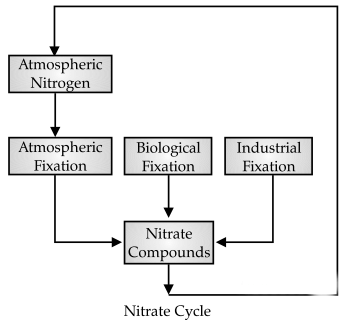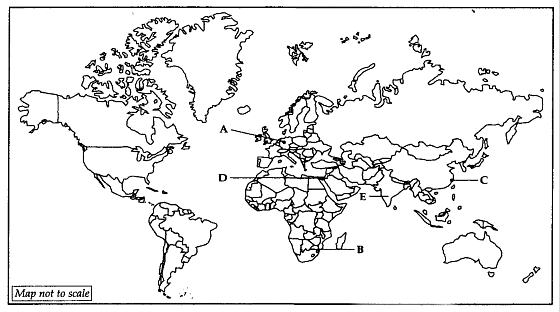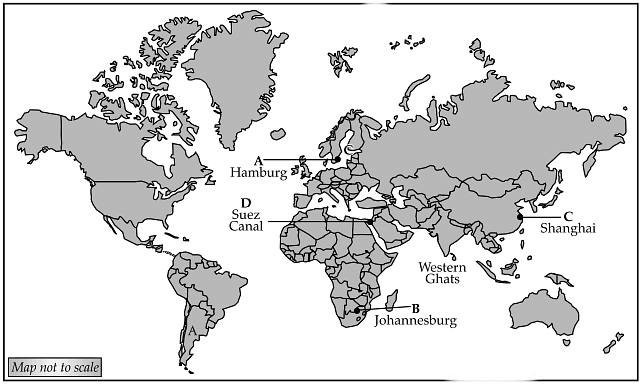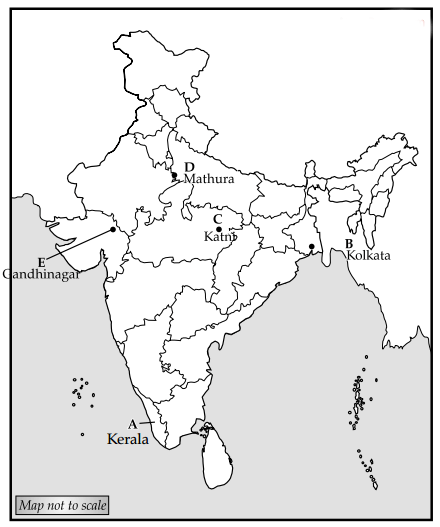CBSE Sample Question Paper (2022-23) - 6 | Geography Class 11 - Humanities/Arts PDF Download
Time Allowed: 2 Hours
Maximum Marks: 80
General Instructions
- All questions are compulsory.
- Question number 1 to 14 are Multiple choice questions carrying 1 mark each.
- Question number 15 to 16 are Multiple source based questions carrying 3 marks each.
- Question number 17 to 21 are Short-answer questions carrying 3 marks each. Answer to each of these questions should not exceed 80-100 words.
- Question number 22 to 26 are Long-answer questions carrying 5 marks each. Answer to each of these questions should not exceed 150 words.
- Question number 27 and 28 are related to identification or locating and labelling of geographical features on maps, carrying 5 marks each.
Q1. comprises of country/rural and town/urban planning. [1]
(a) Regional development
(b) Regional approach
(c) Regional planning
(d) Regional segregation
Ans: (c) Regional planning
Q2. All planets were formed around: [1]
(a) 4.6 billion years ago
(b) 3.6 billion years ago
(c) 2.6 billion years ago
(d) 1.6 billion years ago
Ans: (a) 4.6 billion years ago
Q3. The most explosive of the earth’s volcanoes are called: [1]
(a) Caldera
(b) Lapoliths
(c) Dykes
(d) Asthenosphere
Ans: (a) Caldera
Q4. Rocks closer to the mid-oceanic ridges are: [1]
(a) oldest
(b) youngest
(c) thinnest
(d) heaviest
Ans: (b) youngest
Q5. The solid mineral material forming part of the surface of the earth is called: [1]
(a) rock
(b) magma
(c) sand
(d) silt
Ans: (a) rock
Q6. The land building forces are known as the: [1]
(a) endogenic forces
(b) exogenic forces
(c) geomorphic forces
(d) orogeny
Ans: (a) endogenic forces
Q7. Which one of the following processes is a gradational process: [1]
(a) Deposition
(b) Diastrophism
(c) Volcanism
(d) Erosion
Ans: (d) Erosion
Q8. A ridge of sand and shingle formed in the sea in the off-shore zone lying approximately parallel to the coast is called an: [1]
(a) off-shore bar
(b) in-shore bar
(c) Outside shore bar
(d) Inside shore bar
Ans: (a) off-shore bar
Q9. The gas that is transparent to the incoming solar radiation but opaque to the outgoing terrestrial radiation is known as : [1]
(a) carbon dioxide
(b) oxygen
(c) nitrogen
(d) helium
Ans: (a) carbon dioxide
Q10. The atmosphere is indirectly heated by the earth’s: [1]
(a) radiation
(b) insulation
(c) convection
(d) advection
Ans: (a) radiation
Q11. The Coriolis Force is the maximum at the: [1]
(a) Equator
(b) Poles
(c) Arctic Circle
(d) Antarctic Ocean
Ans:
(b) Poles
Q12. Arrange the Eastern hills as per the North-South Alignment. [1]
(i) Manipur Hills
(ii) Mizo Hills
(iii) Patkai Hills
(iv) Naga Hills
Options:
(a) i, ii, iii, iv
(b) iii, ii, iv, i
(c) ii, iii, iv, i
(d) iv, ii, i, iii
Ans:
(b) iii, ii, iv, i
Q13. The transformation of water vapour into water is called: [1]
(a) vaporisation
(b) condensation
(c) smog
(d) sublimation
Ans:
(b) condensation
Q14. _________protocol bounds the 35 industrialised countries to reduce their emissions by the year 2012 to 5 percent less than the levels prevalent in the year 1990. [1]
(a) Nato
(b) Kyoto
(c) European
(d) UN
Ans:
(b) Kyoto
Q15. Read the case study given below and answer any three of the questions that follow.
The history of map-making is as old as the history of humankind itself. The oldest map was found in Mesopotamia drawn on a clay tablet that belongs to 2,500 B.C. Greek and the Arab geographers laid the foundation of modern cartography. The measurement of the circumference of the Earth and the use of the system of geographical coordinates in map-making are some of the significant contributions of the Greeks and the Arabs.
The art and science of map making was revitalised in early modern period, with extensive efforts made to minimise the effects of the transformation of the geoid onto a plane surface. The maps were drawn on different projections to obtain true directions, correct distances and to measure area accurately. The aerial photography supplemented the ground method of survey and the uses of aerial photographs stimulated map-making in the nineteenth and twentieth centuries.
(i) The history of map making is as old as the history of______itself. [1]
(a) earth
(b) mankind
(c) planet
(d) galaxy
Ans: (b) mankind
(ii) Where was the oldest map found? [1]
(a) India
(b) Antarctica
(c) Mesopotamia
(d) Egypt
Ans: (c) Mesopotamia
(iii) How old was the oldest map that was found? [1]
(a) Belonged to 2,500 BC
(b) Belonged to 2,500 DC
(c) Belonged to 2,500 AD
(d) None of the above
Ans: (a) Belonged to 2,500 BC
Q16. Read the case study given below and answer any three of the questions that follow.
A The Nilgiri Biosphere Reserve (NBR), the first of the fourteen biosphere reserves of India, was established in September 1986. It embraces the sanctuary complex of Wyanad, Nagarhole, Bandipur and Mudumalai, the entire forested hill slopes of Nilambur, the Upper Nilgiri plateau, Silent Valley and the Siruvani hills. The total area of the biosphere reserve is around 5,5210 sq. km. The Nilgiri Biosphere Reserve possesses different habitat types, unspoilt areas of natural vegetation types with several dry scrubs, dry and moist deciduous, semi-evergreen and wet evergreen forests, evergreen sholas, grasslands and swamps.
It includes the largest known population of two endangered animal species, namely the Nilgiri Tahr and the Lion-tailed macaque. The largest south Indian population of elephant, tiger, gaur, sambar and chital as well as a good number of endemic and endangered plants are also found in this reserve. The habitat of a number of tribal groups remarkable for their traditional modes of harmonious use of the environment are also found here. The topography of the NBR is extremely varied, ranging from an altitude of 250 m to 2,650 m. About 80 percent of the flowering plants reported from the Western Ghats occur in the Nilgiri Biosphere Reserve.
(i) What does NBR stand for? [1]
(a) Nalanda Biosphere Reserve
(b) Nilgiri Biosphere Reserve
(c) National Biosphere Reserve
(d) None of the above
Ans: (b) Nilgiri Biosphere Reserve
(ii) When was the Nilgiri Biosphere Reserve established? [1]
(a) 1976
(b) 1986
(c) 1996
(d) 1966
Ans: (b) 1986
(iii) The total area of the biosphere reserve is around__________sq. km. [1]
(a) 5,520
(b) 5,000
(c) 4,500
(d) 3,500
Ans: (a) 5,520
Q17. Explain in detail the Continental Drift Theory.
Ans: The Continental Drift Theory can be understood through the following points : [3]
(1) Alfred Wegener, a German meteorologist put forth a comprehensive argument in the form of “the Continental Drift Theory” in 1912. This was regarding the distribution of the oceans and the continents.
(2) According to Wegener, all the continents formed a single continental mass, a mega ocean surrounded by the same. The supercontinent was named Pangaea, which meant the entire Earth. The mega ocean was called Panthalassa, meaning the entire water. He argued that, around 200 million years ago, the supercontinent, Pangaea, began to split. Pangaea first broke into two large continental masses as Laurasia and Gondwanaland, forming the Northern and Southern components respectively.
(3) Subsequently, Laurasia and Gondwanaland continued to break into various smaller continents that exist today. A variety of evidence was offered in support of the continental drift.
Q18. Define the term ‘Wind’. Explain different types of winds. [3]
Ans: The air in motion is known as wind. The different types of winds are:
(1) Seasonal Wind: The pattern of wind circulation is modified in different seasons due to the shifting of regions of maximum heating, pressure and wind belts. The most pronounced effect of such a shift is noticed in the monsoons, especially over Southeast Asia.
(2) Local Winds: Differences in the heating and cooling of Earth surfaces and the cycles those develop daily or annually can create several common, local or regional winds.
(3) Mountain and Valley Winds: In mountainous regions, during the day, the slopes get heated up and air moves upslope and to fill the resulting gap, the air from the valley blows up in the valley. This wind is known as the valley breeze.
Q19. Mention the factors that affect the distribution of temperature of ocean water. [3]
Ans: The factors, which affect the distribution of temperature of ocean water, are:
(1) Latitude: The temperature of surface water decreases from the equator towards the poles because the amount of insolation decreases polewards.
(2) Unequal distribution of land and water: The oceans in the Northern hemisphere receive more heat due to their contact with a larger extent of land than the oceans in the Southern hemisphere.
(3) Prevailing wind: The winds blowing from the land towards the oceans drive warm surface water away from the coast resulting in the upwelling of cold water from below. It results in the longitudinal variation in the temperature. Contrary to this, the onshore winds pile up warm water near the coast and this raises the temperature.
(4) Ocean currents: Warm ocean currents raise the temperature in cold areas while the cold currents decrease the temperature in warm ocean areas. Gulf Stream (warm current) raises the temperature near the eastern coast of North America and the West coast of Europe while the Labrador Current (cold current) lowers the temperature near the North-East coast of North America.
Q20. Explain the features of El-Nino. [3]
Ans: El-Nino is a complex weather system that appears once every three to seven years, bringing drought, floods and other weather extremes to different parts of the world. The various features of El-Nino are :
(1) The system involves oceanic and atmospheric phenomena with the appearance of warm currents off the coast of Peru in the Eastern Pacific and affects weather in many places including India.
(2) El-Nino is merely an extension of the warm equatorial current, which is replaced temporarily by cold Peruvian current or Humboldt current.
(3) This current increases the temperature of water on the Peruvian coast by 10 °C.
Q21. What are the conditions for the occurrence of cyclones? [3]
Ans: Some initial conditions for the emergence of a tropical cyclone are:
(1) Large and continuous supply of warm and moist air that can release enormous latent heat.
(2) Strong Coriolis force that can prevent filling of low pressure at the centre (absence of Coriolis force near the equator prohibits the formation of tropical cyclone between 0°-5° latitude).
(3) Unstable condition through the troposphere that creates local disturbances around which a cyclone develops.
(4) Finally, the absence of strong vertical wind wedge, which disturbs the vertical transport of latent heat.
Q22. Explain in detail about the nitrogen cycle. Draw and label the diagram. [5]
Ans: Nitrogen is a major constituent of the atmosphere comprising about 79% of the atmospheric gases. It is also an essential constituent of different organic compounds such as the amino acids, nucleic acids, proteins, vitamins and pigments. Only a few types of organisms like certain species of soil bacteria and blue-green algae are capable of utilising it directly in its gaseous form. Generally, nitrogen is usable only after it is fixed. 99% of fixed nitrogen is biological. The principal source of free nitrogen is the action of soil micro-organisms and associated plant roots on atmospheric nitrogen found in pore spaces of the soil. Nitrogen can also be fixed in the atmosphere through lightning and cosmic radiation.
In the oceans, some marine animals can fix it. After atmospheric nitrogen has been fixed into an available form, green plants can assimilate it. Herbivorous animals feeding on plants, in turn, consume some of it. Dead plants and animals, excretion of nitrogenous wastes are converted into nitrites by the action of bacteria present in the soil. Some bacteria can even convert nitrites into nitrates that can be used again by green plants. There are still other types of bacteria capable of converting nitrates into free nitrogen, a process known as denitrification.
Q23. Write a detailed note on the Northern Plains. [5]
Ans: The Northern Plains are formed by the alluvial deposits brought by the rivers – the Indus, the Ganga and the Brahmaputra. These plains extend approximately 3,200 km from the East to the West. The average width of these plains varies between 150 and 300 km. The maximum depth of alluvium deposits varies between 1,000 and 2,000 m. From the North to the South, these can be divided into three major zones: the Bhabar, the Tarai and the alluvial plains.
(1) Bhabar: It is a narrow belt ranging between 8–10 km parallel to the Shiwalik foothills at the break-up of the slope. Because of this, the streams and rivers coming from the mountains deposit heavy materials of rocks and boulders, and at times, disappear in this zone.
(2) Tarai: Its approximate width is 20–30 km where most of the streams and river re-emerge without having any properly demarcated channel, thereby, creating a marshy and swampy condition known as the Tarai. It has a luxurious growth of natural vegetation and houses a varied wildlife.
(3) Alluvial Plains: These plains have characteristic features of the mature stage of fluvial erosional and depositional landforms such as sandbars, meanders, ox-bow lakes and braided channels. The Brahmaputra plains are known for their riverine islands and sandbars. Most of these areas are subjected to periodic floods and shifting river courses forming braided streams.
The mouths of these mighty rivers also form some of the largest deltas of the world, for example, the famous Sunderbans delta. This is a featureless plain with a general elevation of 50–150 m above the mean sea level. The states of Haryana and Delhi form a water divide between the Indus and the Ganga river systems. In contrary to this, the Brahmaputra river flows from the Northeast to the Southwest direction before it takes an almost 90° Southward turn at Dhubri before it enters into Bangladesh.
Q24. Explain the important features of the south-west monsoon season. [5]
Ans: Important features of the South-West Monsoon Season:
(1) The Southeast trade winds cross the equator and enter the Bay of Bengal and the Arabian Sea, only to be caught up in the air circulation over India. Passing over the equatorial warm currents, they bring with them moisture in abundance. After crossing the equator, they follow a Southwesterly direction. That is why they are known as South-West monsoons.
(2) The rain in the South-West monsoon season begins rather abruptly. One result of the first rain is that it brings down the temperature substantially.
(3) This sudden onset of the moisture-laden winds associated with violent thunder and lightning is often termed as the “break” or “burst” of the monsoon. The monsoon may burst in the first week of June in the coastal areas of Kerala, Karnataka, Goa and Maharashtra, while in the interior parts of the country, it may be delayed to the first week of July. The day temperature registers a decline of 5°C to 8°C between mid-June and mid-July.
(4) As these winds approach the land, their Southwesterly direction is modified by the relief and thermal low pressure over Northwest India. The monsoon approaches the landmass in two branches:
(a) The Arabian Sea branch and
(b) The Bay of Bengal branch.
(5) The monsoon winds originating from the Arabian Sea are further divided into three branches: Its one branch is obstructed by the Western Ghats. Another branch of the Arabian Sea monsoon strikes the coast North of Mumbai. The third branch of this monsoon wind strikes the Saurashtra Peninsula and the Kachchh. The Bay of Bengal branch strikes the coast of Myanmar and part of Southeast Bangladesh.
Q25. Explain the different types of soil erosion. [5]
Ans: The different types of soil erosion are:
(1) Surface erosion: When rain, wind or frost detaches soil particles from the surface, the particles are washed or blown off the paddock.
(a) Sheet erosion: Sheet erosion takes place on level lands after a heavy shower and the soil removal is not easily noticeable. However, it is harmful since it removes the finer and more fertile topsoil. It lowers the fertility of the soil.
(b) Wind erosion: Wind erosion has the ability to remove soil and transport it. Wind erosion is significant in arid and semi-arid regions. In regions with heavy rainfall and steep slopes, erosion by running water is more significant.
(c) Water erosion: Water erosion, which is more serious and occurs extensively in different parts of India, takes place mainly in the form of sheet and gully erosion. Sheet erosion takes place on level lands after a heavy shower and the soil removal is not easily noticeable. However, it is harmful since it removes the finer and more fertile topsoil.
(2) Fluvial erosion: This occurs when running water gouges shallow channels or deep gullies into the soil.
(a) Rill erosion: On sloping land, particularly if cultivated, water run-off may gather in small V-shaped channels or rills. These are particularly evident in pumice soils or those formed from loess, but can occur on all hillsides.
(b) Gully erosion: Gully erosion is common on steep slopes. It occurs on unconsolidated subsoils. Gullies deepen with rainfall, cut the agricultural lands into small fragments and make them unfit for cultivation. A region with a large number of deep gullies or ravines is called badland topography. Ravines are widespread in the Chambal basin. Gullies are also found in Tamil Nadu and West Bengal.
Q26. Identify the landslide-prone regions of India and suggest some measures to mitigate the disasters caused by them. [5]
Ans: India has been divided into a number of zones:
- Very High Vulnerability Zone: Highly unstable, relatively young mountainous areas in the Himalayas and Andaman and Nicobar, high rainfall regions with steep slopes in the Western Ghats and Nilgiris, the NorthEastern regions, along with areas that experience frequent ground-shaking due to Earthquakes, etc., and areas of intense human activities, particularly those related to construction of roads, dams, etc. are included in this zone.
- High Vulnerability Zone: Areas that have almost similar conditions to those included in the very high vulnerability zone are also included in this category. The only difference between these two is the combination, intensity and frequency of the controlling factors. All the Himalayan states and the states from the North-Eastern regions except the plains of Assam are included in the high vulnerability zones.
- Moderate to Low Vulnerability Zone: Areas that receive less precipitation such as Trans Himalayan areas of Ladakh and Spiti (Himachal Pradesh), undulated yet stable relief and low precipitation areas in the Aravali, rain shadow areas in the Western and Eastern Ghats and Deccan plateau also experience occasional landslides. Landslides due to mining and subsidence are most common in states like Jharkhand, Odisha, Chhattisgarh, Madhya Pradesh, Maharashtra, Andhra Pradesh, Karnataka, Tamil Nadu, Goa and Kerala.
- Other Areas: The remaining parts of India, particularly states like Rajasthan, Haryana, Uttar Pradesh, Bihar, West Bengal (except district Darjeeling), Assam (except district Karbi Anglong) and coastal regions of the Southern states are safe as far as landslides are concerned.
Measures to mitigate the disaster caused by the landslide:
(1) Restriction on the construction and other developmental activities such as roads and dams, limiting agriculture to valleys and areas with moderate slopes, and control on the development of large settlements in the high vulnerability zones, should be enforced.
(2) This should be supplemented by some positive actions like promoting large-scale afforestation programmes.
(3) Construction of bunds to reduce the flow of water.
(4) Terrace farming should be encouraged in the North-Eastern hill states where Jhumming (Slash and Burn/ Shifting Cultivation) is still prevalent.
Q27. In the given outline map of the world, there are five items marked as A, B, C, D and E. Identify the features with the help of information given below and write their correct names on the map : [5]
A. A major seaport
B. A major airport
C. Mega City
D. Inland waterway
E. Hotspot

Ans:

Q28. Locate and label the following on the political outline map of India : [5]
A. State with highest level of HDI
B. A city with more than 10 million population
C. Bauxite mine
D. Oil Refinery
E. Software technology park
Ans:

|
70 videos|289 docs|44 tests
|




















